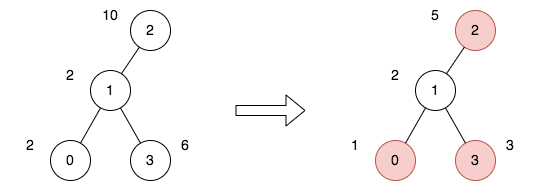Leetcode每日一题学习训练——Python3版(最小化旅行的价格总和)
版本说明
当前版本号[20231206]。
| 版本 | 修改说明 |
|---|---|
| 20231206 | 初版 |
目录
原题可以点击此 2646. 最小化旅行的价格总和 前去练习。
最小化旅行的价格总和
现有一棵无向、无根的树,树中有 n 个节点,按从 0 到 n - 1 编号。给你一个整数 n 和一个长度为 n - 1 的二维整数数组 edges ,其中 edges[i] = [ai, bi] 表示树中节点 ai 和 bi 之间存在一条边。
每个节点都关联一个价格。给你一个整数数组 price ,其中 price[i] 是第 i 个节点的价格。
给定路径的 价格总和 是该路径上所有节点的价格之和。
另给你一个二维整数数组 trips ,其中 trips[i] = [starti, endi] 表示您从节点 starti 开始第 i 次旅行,并通过任何你喜欢的路径前往节点 endi 。
在执行第一次旅行之前,你可以选择一些 非相邻节点 并将价格减半。
返回执行所有旅行的最小价格总和。
示例 1:

输入:n = 4, edges = [[0,1],[1,2],[1,3]], price = [2,2,10,6], trips = [[0,3],[2,1],[2,3]]
输出:23
解释:
上图表示将节点 2 视为根之后的树结构。第一个图表示初始树,第二个图表示选择节点 0 、2 和 3 并使其价格减半后的树。
第 1 次旅行,选择路径 [0,1,3] 。路径的价格总和为 1 + 2 + 3 = 6 。
第 2 次旅行,选择路径 [2,1] 。路径的价格总和为 2 + 5 = 7 。
第 3 次旅行,选择路径 [2,1,3] 。路径的价格总和为 5 + 2 + 3 = 10 。
所有旅行的价格总和为 6 + 7 + 10 = 23 。可以证明,23 是可以实现的最小答案。
示例 2:

输入:n = 2, edges = [[0,1]], price = [2,2], trips = [[0,0]]
输出:1
解释:
上图表示将节点 0 视为根之后的树结构。第一个图表示初始树,第二个图表示选择节点 0 并使其价格减半后的树。
第 1 次旅行,选择路径 [0] 。路径的价格总和为 1 。
所有旅行的价格总和为 1 。可以证明,1 是可以实现的最小答案。
提示:
1 <= n <= 50edges.length == n - 10 <= ai, bi <= n - 1edges表示一棵有效的树price.length == nprice[i]是一个偶数1 <= price[i] <= 10001 <= trips.length <= 1000 <= starti, endi <= n - 1
理解题目
首先需要构建一棵树,然后使用动态规划来计算每个节点作为根节点时的最小价格总和。
在计算过程中,可以选择一些非相邻节点并将价格减半。
简单来说就是:
- 构建树结构
- 初始化动态规划数组
- 遍历所有旅行,计算每个节点作为根节点时的最小价格总和
- 返回最小价格总和
代码思路
-
首先,根据给定的边信息构建一个邻接表来表示树结构。每个节点都有一个子节点列表,用于存储与该节点相连的其他节点。
def minimumTotalPrice(self, n: int, edges: List[List[int]], price: List[int], trips: List[List[int]]) -> int: # 构建邻接表表示树结构 children = [[] for _ in range(n)] for edge in edges: children[edge[0]].append(edge[1]) children[edge[1]].append(edge[0]) -
然后,初始化一个计数器数组
count,用于记录每个节点在行程中出现的次数。# 初始化每个节点的计数器 count = [0] * n -
接下来,使用深度优先搜索(DFS)遍历树结构,计算从起点到终点的路径上的节点数量。在遍历过程中,如果到达终点节点,则将该节点的计数器加一。
# 深度优先搜索,计算从起点到终点的路径上的节点数量 def dfs(node: int, parent: int, end: int) -> bool: if node == end: count[node] += 1 return True for child in children[node]: if child == parent: continue if dfs(child, node, end): count[node] += 1 return True return False -
遍历所有行程,对于每个行程的起点和终点,调用 DFS 函数来计算从起点到终点的路径上的节点数量,并将结果累加到对应节点的计数器中。
# 遍历所有行程,计算每个节点在行程中出现的次数 for [x, y] in trips: dfs(x, -1, y) -
最后,使用动态规划(DP)来计算每个节点作为根节点时的最小总价格。在 DP 函数中,首先计算当前节点作为根节点时的总价格,然后递归地计算其子节点作为根节点时的最小总价格,并根据题目要求进行选择。
# 动态规划,计算每个节点作为根节点时的最小总价格 def dp(node: int, parent: int) -> List[int]: res = [ price[node] * count[node], price[node] * count[node] // 2 ] for child in children[node]: if child == parent: continue [x, y] = dp(child, node) # node 没有减半,因此可以取子树的两种情况的最小值 # node 减半,只能取子树没有减半的情况 res[0], res[1] = res[0] + min(x, y), res[1] + x return res -
最终返回根节点为0时的最小总价格。
# 返回根节点为0时的最小总价格
return min(dp(0, -1))
参考代码
这段代码是一个解决旅行商问题(TSP)的算法,通过构建树结构、计算节点出现次数和使用动态规划来计算旅行商问题的最小总价格。
class Solution:
def minimumTotalPrice(self, n: int, edges: List[List[int]], price: List[int], trips: List[List[int]]) -> int:
children = [[] for _ in range(n)]
for edge in edges:
children[edge[0]].append(edge[1])
children[edge[1]].append(edge[0])
count = [0] * n
def dfs(node: int, parent: int, end: int) -> bool:
if node == end:
count[node] += 1
return True
for child in children[node]:
if child == parent:
continue
if dfs(child, node, end):
count[node] += 1
return True
return False
for [x, y] in trips:
dfs(x, -1, y)
def dp(node: int, parent: int) -> List[int]:
res = [
price[node] * count[node], price[node] * count[node] // 2
]
for child in children[node]:
if child == parent:
continue
[x, y] = dp(child, node)
# node 没有减半,因此可以取子树的两种情况的最小值
# node 减半,只能取子树没有减半的情况
res[0], res[1] = res[0] + min(x, y), res[1] + x
return res
return min(dp(0, -1))
本文来自互联网用户投稿,该文观点仅代表作者本人,不代表本站立场。本站仅提供信息存储空间服务,不拥有所有权,不承担相关法律责任。 如若内容造成侵权/违法违规/事实不符,请联系我的编程经验分享网邮箱:veading@qq.com进行投诉反馈,一经查实,立即删除!